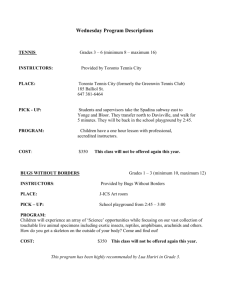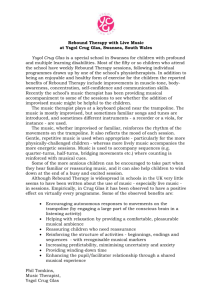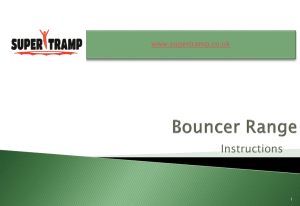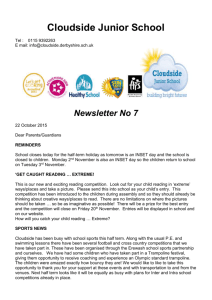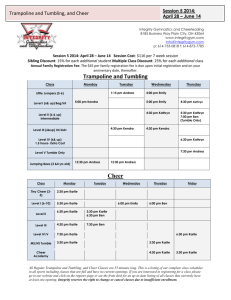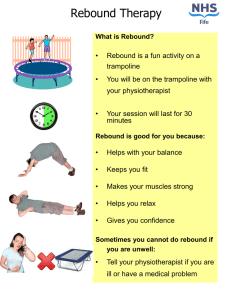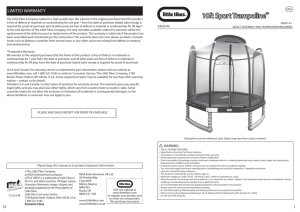Indoor Trampoline Parks
advertisement
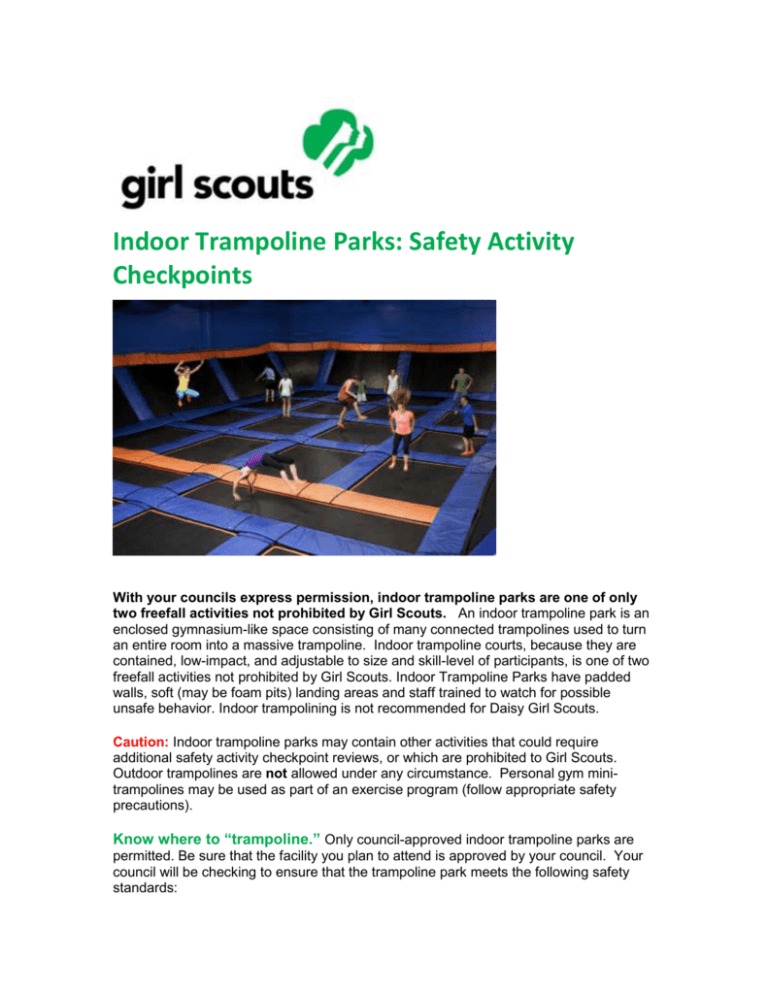
Indoor Trampoline Parks: Safety Activity Checkpoints With your councils express permission, indoor trampoline parks are one of only two freefall activities not prohibited by Girl Scouts. An indoor trampoline park is an enclosed gymnasium-like space consisting of many connected trampolines used to turn an entire room into a massive trampoline. Indoor trampoline courts, because they are contained, low-impact, and adjustable to size and skill-level of participants, is one of two freefall activities not prohibited by Girl Scouts. Indoor Trampoline Parks have padded walls, soft (may be foam pits) landing areas and staff trained to watch for possible unsafe behavior. Indoor trampolining is not recommended for Daisy Girl Scouts. Caution: Indoor trampoline parks may contain other activities that could require additional safety activity checkpoint reviews, or which are prohibited to Girl Scouts. Outdoor trampolines are not allowed under any circumstance. Personal gym minitrampolines may be used as part of an exercise program (follow appropriate safety precautions). Know where to “trampoline.” Only council-approved indoor trampoline parks are permitted. Be sure that the facility you plan to attend is approved by your council. Your council will be checking to ensure that the trampoline park meets the following safety standards: This trampoline facility meets or exceeds ASTM F2970 – 13 – Standard Practice for Design, Manufacture, Installation, Operation, Maintenance, Inspection and Major Modifications of Trampoline Courts. All trampoline courts are at floor level. Each trampoline court is surrounded by a wall enclosures and/or safety netting. Each trampoline bed has a second backup safety trampoline beneath it in the unlikely event the trampoline bed should fail – in accordance with ASTM standards. The steel and springs between the trampoline beds is covered by a minimum of 2 inches of gymnastics grade padding. Each trampoline court must be staffed by employee “monitors”, to monitor the safety of the participants and to insure participants are following the safety guidelines. There should be one “court monitor”, for every 32 kids. Monitors have onboarding training as well as ongoing training. There should be clearly posted rules that prohibit roughhousing, double-bouncing (when two kids land close to each other at the same time) or clothing that could be dangerous, such as belt buckles and studs, and loose objects like key chains. If these rules aren’t being enforced, leave. The trampoline facility has a system in place to handle participants if they are not following the safety guidelines. Trampolines shouldn’t be crowded. They should be divided into clearly marked 6foot-by-10-foot areas. Only one person at a time should be allowed to bounce in each area. Little kids should not be jumping with bigger ones. They should be separated by height and weight. All participants, even returning participants, must review the safety guidelines before participating in any activities on the trampolines. These safety guidelines are reviewed via video or in person at the facility. Participants are required to wear appropriate clothing, including footwear. For facilities with foam pits: Foam pits are cleaned weekly – foam squares are removed, disinfected, and returned to the pit. Damaged foam squares are replaced. Include girls with disabilities. Communicate with girls and/or their caregivers to assess any needs and accommodations. Indoor trampoline parks are not recommended for pregnant women and people with previous or recurring back, shoulder, or neck problems, and some facilities also have weight restrictions and requirements for participants. Note that some facilities may prohibit people with any of the previously mentioned conditions from participating. Get specifics from the indoor trampoline facility you plan to attend. Indoor Trampoline Gear Recommended Gear Comfortable clothes Appropriate footwear (as required by the facility) Prepare for Indoor Trampolining Communicate with council and parents. See the Introduction to Safety Activity Checkpoints. Girls plan the activity. See the Introduction to Safety Activity Checkpoints. Arrange for transportation and adult supervision. See the Introduction to Safety Activity Checkpoints for the recommended adult-to-girl ratios. Verify instructor knowledge and experience. Ensure that the trampoline court is staffed by employee “monitors” to monitor the safety of participants and ensure that participants are following safety guidelines. Staff should receive safety and emergency preparedness training on an annual basis. Compile key contacts. See the Introduction to Safety Activity Checkpoints. Size up gear. Make certain that girls with glasses or contacts have goggles that properly accommodate them. Safeguard valuables. Don’t leave personal belongings and valuables unattended in a public place. Most indoor trampoline parks provide a locker area for personal belongings. Check with the facility ahead of time about cost and availability of the facility’s storage amenities. Dress appropriately for the activity. Make sure girls and adults are not wearing jewelry, excessive clothing or hats. Prepare for emergencies. Ensure the presence of a first-aid kit and a first-aider with a current certificate in First Aid, including Adult and Child CPR or CPR/AED, who is prepared to handle cases of abrasions, sprains, and fractures. Emergency transportation is available; if any part of the activity is located 30 minutes or more from emergency medical services ensure the presence of a first-aider with Wilderness First Aid. See Volunteer Essentials for information about first-aid standards and training. On the Day of Trampolining Girls learn how to trampoline safely. All participants (including returners) will be given instruction in safety and jumping rules. All legitimate centers provide instruction; it is up to the adult organizing this activity to ensure this is so. Safety rules include*: You may not have anything in your mouth (gum, candy, etc.) on the court. Empty your pockets entirely. Do not sit or lie on the court. If you are tired and need to rest, you must exit the court. No pushing, tackling, running, racing or horseplay of any kind. Do not touch or hang on to any of the top pads on the court. No double bouncing. Single flips are permitted. No double flips, and do not flip over the pads. No more than two flips in a row. Flips and other tricks can be dangerous ... perform at your own risk. You can bounce and flip off the sidewalls, but you must land on the first trampoline next to the wall you bounced off of. You must be in control of your body at all times. Do not attempt anything outside of your personal limitations or abilities. Jumpers are separated by size as best as possible. Be aware of those around you and jump with people that are of similar size. Use the buddy system. See the Introduction to Safety Activity Checkpoints. Keep in mind, however, the buddy system only applies to activity outside the trampolines, as only one participant at a time is allowed on a trampoline. Indoor Trampoline Links International Association of Trampoline Parks: http://www.indoortrampolineparks.org/assets/docs/iatp%20press%20relea se%203.3.15.pdf *These checkpoints must be reviewed with the vendor and/or facility, when appropriate.


